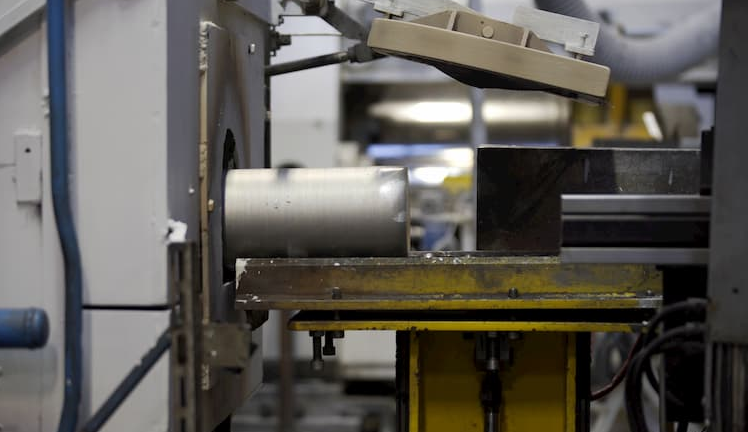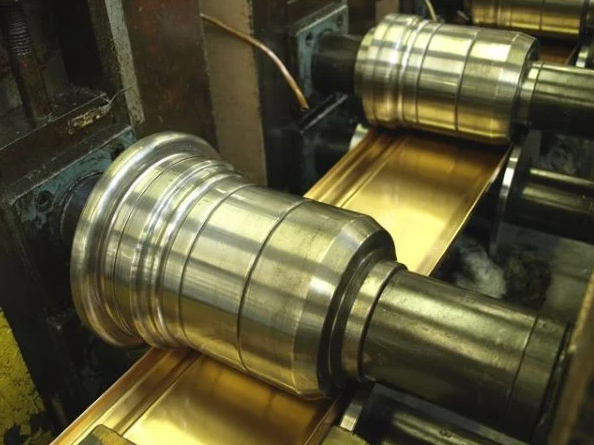Extrusion offers greater flexibility and precision compared to rolling, making it ideal for complex shapes and tight tolerances.
Fundamentals of Extrusion and Rolling Processes
Overview of Extrusion Process
Extrusion is a metal forming process in which a workpiece is forced through a die to create a desired cross-sectional shape. This technique is known for its high production speed and ability to create complex cross-sections. In extrusion, the material, often heated, is pushed through a die, which shapes it into a continuous length of a specific cross-section.

Key Parameters:
Power Consumption: The process typically requires high power input, ranging from 20 to 200 kW depending on the material and complexity.
Efficiency: Extrusion is highly efficient in material usage, often reaching efficiency rates of up to 90-95%.
Cost Factors: Initial setup costs can be high, but the per-unit production cost is low, making it cost-effective for large-scale production.
Advantages:
High Production Speed: Rates can exceed several meters per minute, depending on the material.
Versatility in Materials: Suitable for various metals, including aluminum, copper, and steel.
Quality: Consistently high-quality finish and uniform cross-sections.
Disadvantages:
Limited to Uniform Cross-Sections: Can’t create variable cross-sections along the length.
Initial Setup Cost: High due to the cost of custom dies and machinery.
Overview of Rolling Process
Rolling involves passing metal stock through one or more pairs of rolls to reduce thickness, increase length, or change the cross-section. This process is primarily used for producing sheet metal and can be classified into hot and cold rolling based on the temperature of the metal being processed.
Key Parameters:
Power Requirements: Power consumption varies widely but is generally lower than extrusion, typically ranging from 5 to 50 kW.
Efficiency: Material wastage is minimal in rolling, with efficiency often above 80-90%.
Cost Factors: Lower initial investment than extrusion, but maintenance costs for rollers can be significant.
Advantages:
Material Strength: Increases strength due to hardening of the material.
Dimensional Accuracy: High precision in thickness and flatness of produced sheets.
Scalability: Suitable for large-scale production with relatively lower costs.
Disadvantages:
Speed Limitations: Generally slower than extrusion, especially in complex profiles.
Shape Limitations: Primarily limited to flat or slightly curved shapes.
In these processes, factors such as energy efficiency, production costs, and material properties play crucial roles in determining their suitability for specific applications.
Mechanical Properties and Material Behavior
Enhancements in Material Strength through Extrusion
Extrusion significantly impacts the material’s mechanical properties. The process aligns the metal’s grain structure along the direction of flow, enhancing its strength, particularly in tensile and fatigue resistance.
Tensile Strength Increase: Metals exhibit an increase in tensile strength, often by 10-30%, compared to their original form.
Fatigue Resistance: Due to the aligned grain structure, extruded materials often show improved fatigue resistance, making them ideal for cyclic load applications.
Thermal Stability: Extruded materials maintain their mechanical properties over a wide temperature range.
Key Advantages:
Customizable Material Properties: By adjusting the extrusion process parameters like temperature and speed, specific material properties can be targeted.
High-Quality Surface Finish: Extrusion provides a smooth finish, reducing the need for additional surface treatments.
Considerations:
Cost Implications: While extrusion enhances material strength, the initial setup and operational costs can be significant.
Material Limitations: Not all materials can be extruded effectively, which limits the range of applications.
Texture and Grain Structure in Rolled Materials
Rolling influences the texture and grain structure of metals, affecting their mechanical properties. This process elongates the grains and induces a fibrous texture, which is beneficial for certain applications.
Grain Elongation: Rolling causes the grains to elongate in the rolling direction, which can enhance ductility and reduce brittleness.
Anisotropy in Properties: The elongated grains lead to anisotropy, where the material exhibits different properties in different directions.
Key Advantages:
Improved Surface Quality: Rolled materials often have a superior surface finish, beneficial for aesthetic and functional purposes.
Versatility in Applications: The varied grain structure makes rolled materials suitable for diverse applications, from construction to automotive industries.
Considerations:
Inherent Anisotropy: While often advantageous, anisotropy can be a limitation in applications requiring uniform properties in all directions.
Process Limitations: Rolling is typically limited to uniform thicknesses and simple shapes.
Both extrusion and rolling processes have profound effects on the mechanical properties and behavior of materials.
Efficiency and Productivity Considerations
Production Speed: Extrusion vs. Rolling
Extrusion and rolling are two distinct manufacturing processes, each with unique efficiency characteristics, particularly in terms of production speed.

Extrusion Speed: The speed of extrusion can vary significantly, but it is generally faster for simpler shapes. Speeds can range from 0.5 to 50 meters per minute, depending on the material and cross-sectional complexity.
Rolling Speed: Rolling, particularly in high-volume production, can reach speeds of up to 100 meters per minute for basic flat products.
Key Factors Affecting Speed:
Material: Harder materials typically slow down both processes.
Cross-Section Complexity: More complex shapes reduce speed in extrusion.
Thickness: Thinner materials can be rolled faster.
Advantages and Limitations:
Extrusion: Offers high speed for less complex shapes but slows significantly for complex profiles.
Rolling: Consistently high speeds for sheet and flat products but limited in producing varied cross-sections.
Material Utilization and Waste Reduction
Both processes have strategies to maximize material use and minimize waste.
Material Utilization in Extrusion: Extrusion tends to have high material utilization, often above 95%, especially when continuous lengths are produced.
Waste Reduction in Rolling: Rolling is efficient in material use, with waste typically below 5%, mainly due to the process’s nature of deforming rather than removing material.
Key Factors:
Scrap Reuse: Both processes allow for the recycling of scrap material, further enhancing efficiency.
Precision in Production: Advances in control technology have led to more precise material usage, reducing waste.
Economic Implications:
Cost Reduction: Efficient material use directly correlates to lower production costs.
Environmental Impact: Reduced waste contributes to sustainability and environmental conservation efforts.
Both extrusion and rolling have distinct characteristics in terms of production speed and material efficiency.
Applications and Suitability
Ideal Applications for Extruded Products
| Application | Advantages | Considerations |
|---|---|---|
| Construction (e.g., window frames, structural components) | High strength-to-weight ratio, complex shapes possible | Cost-effective only for high-volume production |
| Automotive (e.g., chassis elements, trim parts) | Lightweight, strong, suitable for safety features | Requires precise control of material properties |
| Aerospace (e.g., airframe components) | Ability to form high-strength, lightweight alloys | High initial investment for specialized alloys |
Preferred Uses for Rolled Materials
| Application | Advantages | Considerations |
|---|---|---|
| Sheet Metal (e.g., automotive body panels) | Uniform thickness, smooth surface, high production speed | Limited to simpler, flat or slightly curved shapes |
| Structural Sections (e.g., I-beams, rails) | Consistent strength and dimensions, scalable for large quantities | Not suitable for complex cross-sectional profiles |
| Home Appliances (e.g., refrigerators, washing machines) | Cost-effective for large flat surfaces, easy to paint or treat | Requires additional processes for forming complex shapes |
Key Factors:
- Material Choice: Both processes work best with specific materials. For example, aluminum and certain alloys are ideal for extrusion, while steel and its variants are preferred for rolling.
- Yield: Extrusion is more cost effective in high volume production due to high initial setup costs, while rolling is common in both small and large-scale production.
Economic Implications:
- Cost-Effectiveness: Both processes offer cost benefits in their ideal applications, but the scale of production and complexity of the final product greatly influence the overall cost.
Understanding the applications and suitability of both extrusion and rolling is crucial in selecting the right manufacturing process. This selection impacts not only the quality and performance of the final product but also the efficiency and cost-effectiveness of the production process.




